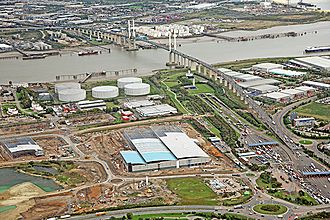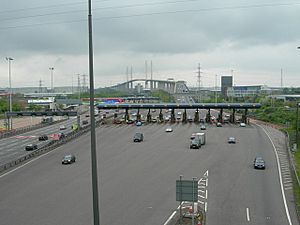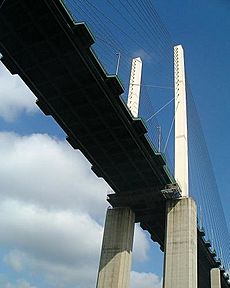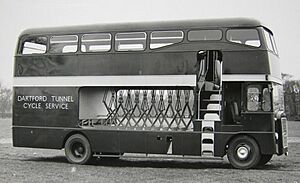Dartford Crossing facts for kids
Quick facts for kids Dartford Crossing |
|
|---|---|

Aerial view of the crossing looking northward. The toll booths were replaced by electronic charging barriers in 2014.
|
|
| General information | |
| Type | 2 tunnels 1 cable-stayed bridge |
| Location | Dartford, Kent Thurrock, Essex |
| Coordinates | 51°27′53″N 0°15′31″E / 51.46472°N 0.25861°E |
| Opened | November 1963 (western tunnel) May 1980 (eastern tunnel) October 1991 (bridge) |
| Height | 200 feet (61 m) (bridge deck) 449 feet (137 m) (bridge tower) |
The Dartford Crossing is a very important road crossing over the River Thames in England. It connects Dartford in Kent (south) with Thurrock in Essex (north). This crossing is part of the A282 road.
It is made up of two tunnels and a large cable-stayed bridge called the Queen Elizabeth II Bridge. It's the only main road crossing of the Thames east of Greater London. This makes it the busiest river crossing in the UK. More than 130,000 vehicles use it every day!
The crossing was built in stages. The first tunnel opened in 1963. The second tunnel opened in 1980. Finally, the big bridge opened in 1991. Even though it's not officially a motorway, it acts like a key part of the M25 motorway. Cars going north use the tunnels, and cars going south use the bridge. Because so many vehicles use it, the crossing often has heavy traffic and gets very busy.
Planning for the crossing began in the late 1930s. However, World War II stopped the work. Building started again in the 1950s. The first tunnel only had one lane for each direction. But traffic grew quickly, so a second tunnel was needed. When the M25 motorway was finished in 1986, it connected to the tunnels. This brought even more traffic. So, a plan was made in 1988 to build the bridge. Now, the whole crossing has four lanes for traffic going in each direction.
People have always had to pay to use the crossing. Even after the building costs were paid off, the charge stayed. From 2003, it became a "congestion charge" to help manage traffic. Since 2008, it's free to use between 10 pm and 6 am. In November 2014, a new electronic system called "Dart Charge" started. This means you pay online, by post, or at shops, not at toll booths. There are special discounts for people who live nearby.
Contents
Where is the Dartford Crossing?
The Dartford Crossing goes over the River Thames. It links Dartford, Kent in the south to Thurrock, Essex in the north. It's about 20 miles (32 km) east of the centre of London. This places it outside the main Greater London area.
The two tunnels are about 4,690 feet (1,430 m) long. The cable-stayed bridge is 449 feet (137 m) high. It has a main section that spans 450 metres (1,480 ft). There is a 50-mile-per-hour (80 km/h) speed limit on the crossing.
The crossing was designed for 135,000 vehicles a day. But it actually carries around 160,000 vehicles daily. It's called a "vital transport link" for the country. It helps connect the M25 motorway around London. Southbound traffic uses the four-lane bridge. Northbound traffic uses the two-lane tunnels. The bridge might close if there are strong winds or for maintenance. When this happens, all traffic uses the tunnels. The crossing has special lights and signs to help manage traffic flow.
Other Ways to Cross the Thames
The closest crossings to the west are the Woolwich Ferry and the Blackwall Tunnel. Both of these are inside East London. If the Dartford Bridge closes due to strong winds, there isn't an easy way for tall vehicles to cross the Thames. They have to drive all the way around the other side of the M25.
New crossings have been suggested to help with traffic. One idea was the Thames Gateway Bridge, but it was cancelled. Another idea is the Lower Thames Crossing. This would be a new tunnel to the east of Dartford. It would connect Shorne, Kent, and South Ockendon, Essex. This new crossing is expected to be finished around 2032.
How Much Does it Cost to Cross?
Since November 2014, the crossing uses an electronic system called Dart Charge. This system uses cameras to read number plates. You can pay online or by phone. You can also pay in advance or by midnight the day after you cross. You cannot pay with cash at the crossing anymore. However, some shops accept cash payments.
You need to pay if you use the crossing between 6 am and 10 pm, any day of the week. Motorcycles can cross for free. Cars, motorhomes, and small minibuses pay £2.50. Larger vehicles like vans and coaches pay more. If you don't pay the charge, you will get a penalty fine.
People living in the Dartford and Thurrock areas can get a discount. For £10 a year, they get 50 crossings. Each extra crossing costs 20p. Another option gives unlimited crossings for £20 a year. About 44,000 drivers use this special scheme every year.
History of the Crossing
First Tunnel (Western Tunnel)

The idea for a tunnel crossing came up in 1924. By 1929, it was estimated to cost £3 million. This tunnel was meant to be part of a new road around London. Work on a small pilot tunnel started in 1936. But World War II stopped the main construction.
Work began again in 1959. Engineers used a special machine called a Tunnelling shield to dig. The war delay actually helped improve the tunnel's design, including its ventilation system. The first two-lane tunnel opened on 18 November 1963. It cost £13 million to build. About 12,000 vehicles used it each day at first.
The original toll was two shillings and sixpence (about 12.5p today). In 1977, the toll for cars went up to 35p. By 1984, it was 60p for cars.
Second Tunnel (Eastern Tunnel)
The first tunnel was expected to carry two million vehicles a year. But by 1970, it was carrying over eight million! So, in 1970, the government announced that a second tunnel would be built. This new tunnel would be part of the M25 motorway.
Building the second tunnel was approved in 1971. But there were delays because of money problems. These were solved with help from the European Economic Community (EEC). The second tunnel opened in May 1980. This meant each tunnel could handle traffic going in one direction. The two tunnels together could now handle 65,000 vehicles a day.
The crossing was fully connected to the M25 motorway in 1986. After the M25 was finished, traffic jumped to 79,000 vehicles a day.
Queen Elizabeth II Bridge
By the mid-1980s, it was clear that the two tunnels would not be enough for all the M25 traffic. In 1986, a company called Trafalgar House won a bid to build a new bridge. This bridge was valued at £86 million.
Work on the bridge started in 1988. It was designed by a German engineer named Hellmut Homberg. The two main parts that support the bridge were built in the Netherlands. Each of these parts was designed to withstand a large ship hitting it. The bridge deck is about 61 metres (200 ft) high. During construction, a World War II bomb was found, which closed the crossing for a short time.
Queen Elizabeth II opened the bridge on 30 October 1991. It cost £120 million to build, including the roads leading to it. When it opened, it was the longest cable-stayed bridge in Europe. It is the only bridge across the Thames east of Central London to be opened since Tower Bridge in 1894.
Changes to the Charging System
In 2000, the European Union said that all road tolls should include a tax. The UK government decided to pay this extra cost itself. The tolls were supposed to be removed in 2003. But the Highways Agency decided to keep them as a "charge" instead. This was allowed under a new law.
In 2009, a new company, Connect Plus (M25) Limited, took over managing the crossing. They also had to widen parts of the M25. In 2009, the government thought about selling the crossing. But local people did not like this idea. So, the charges were increased instead to help the government's budget.
In 2008, charges between 10 pm and 6 am were stopped. But daytime charges went up. By 2012, local businesses complained that the payment booths were causing too much traffic. So, the government announced a new electronic charging system for 2014. This system, called Dart Charge, lets drivers pay by phone, text, online, or in shops. The old payment booths were removed in November 2014.
The Dart Charge system has helped reduce travel times during busy periods. However, some reports show that many fines have been given out for not paying. In 2023, a system upgrade caused problems for some users trying to pay.
Traffic and How People Use It
As of 2015, over 1.5 billion journeys had been made across the Dartford Crossing. The busiest day ever was 23 July 2004, with 181,990 vehicles. The crossing makes a lot of money each year from the charges.
Bus Services
There is one bus service that uses the crossing. It's the X80, run by Ensignbus. It travels between Lakeside Shopping Centre and Bluewater.
Cycling Across
Bicycles are not allowed on the crossing. But cyclists can get a free ride across. They go to the crossing control offices on either side. They use a free phone to call for a special vehicle. This ride usually takes about 15 to 30 minutes.
In 1963, special double-decker buses were used to take cyclists through the tunnel. The lower deck was for bikes, and the upper deck was for people. But this service was expensive and not used much. It was stopped in 1965 and replaced with the current transfer service.
Dangerous Loads
Vehicles carrying dangerous goods have special rules for crossing. The Dartford Crossing is a "Class C" crossing. This means some dangerous goods, like certain liquids, are not allowed. Some very large or dangerous vehicles might need an escort from traffic officers. The crossing also holds practice drills with emergency services. This helps them prepare for any problems.
Safety and Speed
Traffic officers patrol the tunnel. They can stop and direct traffic. Speed cameras enforce the speed limit. Between 2012 and 2014, over 24,000 drivers were caught speeding. Some were going as fast as 94 miles per hour (151 km/h)! The bridge also has a lower speed limit of 30 miles per hour (48 km/h) in strong winds. It closes completely if winds are too strong.
Traffic Jams
The Dartford Crossing is the busiest in the UK. It carries about 160,000 vehicles every day. Because so many cars use it, there are often big traffic jams. This is especially true during busy times. This also causes more air pollution in nearby areas.
Even though the Queen Elizabeth II Bridge was designed to stay open in strong winds, it sometimes has to close. This causes even more traffic problems. In 2004, a survey said the crossing was the "most stressful section of the M25." In 2009, it was listed as one of the most congested roads in Britain. While electronic charging has helped, many still believe a new crossing is needed to truly fix the traffic problems.
What's Next for the Crossing?
Since the 2000s, plans have been made for another crossing of the Thames. This would help reduce the traffic at the Dartford Crossing. Different ideas have been looked at, including a new crossing near Swanscombe or Tilbury.
In 2017, a route for a new crossing was chosen. It will connect the M25 at North Ockendon to the A2 at Thong. This new road will be about 14.3 miles (23.0 km) long. It will have a 2.6 mi (4.2 km) twin-bore tunnel under the River Thames. This new crossing is expected to cost between £6.4 billion and £8.2 billion. It should take about six years to build once permission is given.







